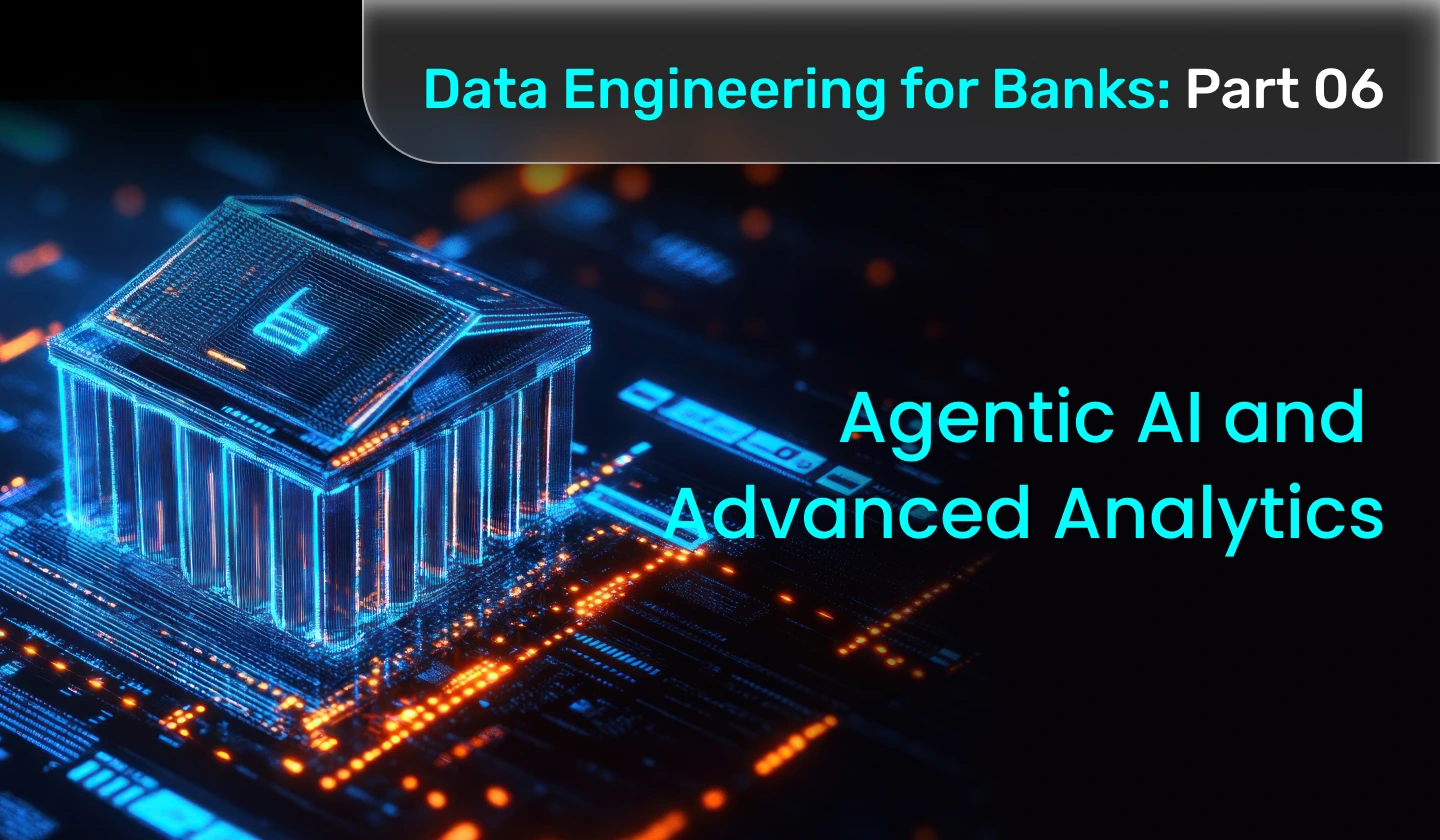 16 mins
16 mins
Aug 05, 2025

This is the sixth blog in our Data Engineering for Banks series. If you haven’t read the previous ones, explore them here:
→ Why EU Banks Need Stronger Data Engineering
→ Data Engineering Starts with a Data Assessment
→ Designing a Robust Data Architecture for Banking
Over the past few years, banks across Europe have invested heavily in building strong data foundations. Data lakes, governance frameworks, and integration pipelines are already in place. These efforts have made compliance smoother and reporting more accurate.
But a new shift is underway. The conversation is shifting from storing or reporting on data to making decisions in real time.
Agentic AI is representing a new class of intelligent systems that don’t just analyze data, but act on it, adapt to context, and continuously improve.
For EU banks, this is the logical next step in turning engineered data into business outcomes.
Traditional analytics shows you the road ahead.
But agentic AI is like a co-pilot that reads the road, adjusts your speed, and even recommends alternate routes in real time.
● Unlike static dashboards, Agentic AI systems are autonomous, context-aware, and action-oriented.
● They augment bankers by monitoring complex data flows and making recommendations or interventions instantly.
For banks operating under GDPR, Basel III, and the EU AI Act, this evolution is the path to staying compliant, competitive, and customer-focused.
Agentic AI only works if the data it consumes is clean, complete, and real-time. This is why data engineering remains the foundation:
● Data quality: Eliminates errors and inconsistencies that could mislead agents.
● Integration: Brings together core banking, payments, CRM, and regulatory systems into a single stream of truth.
● Real-time pipelines: Ensure that decisions (fraud detection, credit approvals) happen instantly.
● Governance: Keeps every action explainable and audit-ready for EU regulators.
Banks already use analytics to describe what happened and predict what might happen. Agentic AI takes it further by acting in the present moment.
Examples in EU banking:
This evolution shifts banking analytics from being a reporting function to being a living, responsive system that shapes outcomes in real time.
European banks face unique challenges and opportunities in adopting Agentic AI. This includes:
➡️ Regulation First: Compliance with GDPR and the EU AI Act requires transparency and auditability. Data engineering ensures that every AI action is traceable.
➡️ Cross-Border Complexity: EU banks often span multiple jurisdictions, which requires agents that can adapt to diverse regulatory frameworks.
➡️ Building customer trust: Agents must not only make decisions, but also explain them in plain language (e.g., why a loan was approved or denied).
These considerations make responsible AI design essential and reinforce the importance of solid data engineering.
The most successful banks will take an incremental, engineered approach:
1️⃣ Assess data readiness: Ensure pipelines are clean, governed, and available in real time.
2️⃣ Start with low-risk agents: Deploy Agentic AI in compliance or fraud monitoring before customer-facing use cases.
3️⃣ Bridge teams: Build collaboration between data engineering, data science, and business functions.
4️⃣ Scale responsibly: Once trust is established internally, expand agents into lending, customer experience, and operations.
This roadmap allows banks to learn, adapt, and scale without losing compliance or customer trust.
Want to know more in detail? Read this expert-prepared guide on: AI Agents in Banking
Agentic AI depends on clean, integrated, and governed data. Data engineering provides the foundation by ensuring data quality, building real-time pipelines, and maintaining compliance with EU regulations such as GDPR and the EU AI Act. Without this foundation, AI agents cannot deliver reliable or explainable outcomes.
Key applications include:
✔️ Fraud detection and anti-money laundering (AML).
✔️ Credit scoring and real-time loan approvals.
✔️ Personalized customer services and recommendations.
✔️ Automated compliance monitoring and reporting.
✔️ Real-time liquidity and risk management.
The EU AI Act emphasizes transparency, explainability, and risk classification. Agentic AI built on engineered data pipelines ensures that every decision is traceable, audit-ready, and aligned with regulatory requirements.
Advanced analytics helps banks identify patterns, predict outcomes, and generate insights. When combined with Agentic AI, these insights move from static reports to dynamic, real-time actions such as instantly flagging fraudulent activity or proactively offering a customer a tailored loan.
For customers, Agentic AI means faster loan approvals, personalized financial advice, real-time fraud protection, and more transparent decision-making. This enhances trust and improves the overall customer experience.
1️⃣ Agentic AI:A new class of artificial intelligence systems that go beyond analysis to act autonomously, adapt to changing contexts, and continuously improve.
2️⃣ Advanced Analytics: A set of data analysis techniques, including predictive modeling, machine learning, and real-time analytics, that go beyond traditional reporting to uncover patterns, forecast outcomes, and guide decision-making.
3️⃣ Data Engineering: The process of designing, building, and maintaining data pipelines that ensure data is collected, cleaned, integrated, and governed so it can be used effectively for analytics and AI.
4️⃣ Data Governance: A framework of policies, standards, and practices that ensures data is accurate, secure, compliant, and used responsibly, especially critical under regulations such as GDPR and the EU AI Act.
5️⃣ Data Pipeline: The sequence of processes that move data from source systems to destinations such as data lakes, warehouses, or AI models.